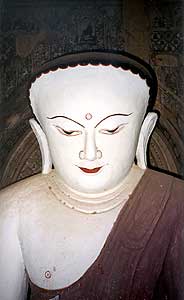|
The
early history of Burma
Burma's early history is practically uncharted but by the 8th century the Mons - who probably originated in Central Asia - occupied the lower portions of the Irrawaddy basin, while the Burmans had established themselves on the upper reaches of the Irrawaddy. Burma's subsequent violent history largely concerns the struggle between these 2 predominant racial groups. Kings fought wars in order to carry off slaves from the kingdoms they conquered; it was important to have a large
labor force to build temples and pagodas and to grow rice.
The Glass Palace Chronicle of the Kings of Burma (a 19th century historical mythology) claims that the Burmese kings were descendants of the Buddha's family but historians have found no evidence of any ruler before the 1th century King Anawrahta of Pagan. From the 10th century on, the Burmans were the largest group; they were also the most important in terms of their historical, cultural and political contribution to Burma's heritage. Between the I7th and 19th centuries, the Burmans succeeded in uniting the country under one monarch on 3 separate occasions. When each of these empires fragmented, Burma became a muddle of quarrelling races. In the 19th century, the Burmese frequently clashed with the British and were defeated in 1885, resulting in the capture and exile of the last king. Early history
There are traces of some form of settlement in Burma as far back as 2,500-2,000 BC. The Pyus were the first settlers and occupied the upper Irrawaddy River. The early
Pyu city of Sri Kshetra, near present day Prome, was enclosed in a massive wall and was possibly even bigger than the later Burmese cities of Pagan and Mandalay. When the Pyu capital was captured and the people enslaved by the
neighboring power in Yunnan, the Burmese moved into the power vacuum in the Irrawaddy area. The Burmese came to dominate both the Ryu and the Mon.
The Mons settled in the lower Irrawaddy delta region around Thaton and were the first people to establish Buddhism in Burma. Little is known about the earliest phases of Mon art - although their artistic and architectural skills were obviously coveted and their works have been unearthed not just in Burma, but also in Thailand and Cambodia. The great King Anawrahta brought Mon craftsmen to Pagan where their temple and stupa designs characterized the first recognizable architectural 'period' - the Mon Period. The last group to migrate from China were the Tai, who fled the Mongul invasions from the 9th-11th centuries and settled in the hills on the present Thai-Burma
border.
|

